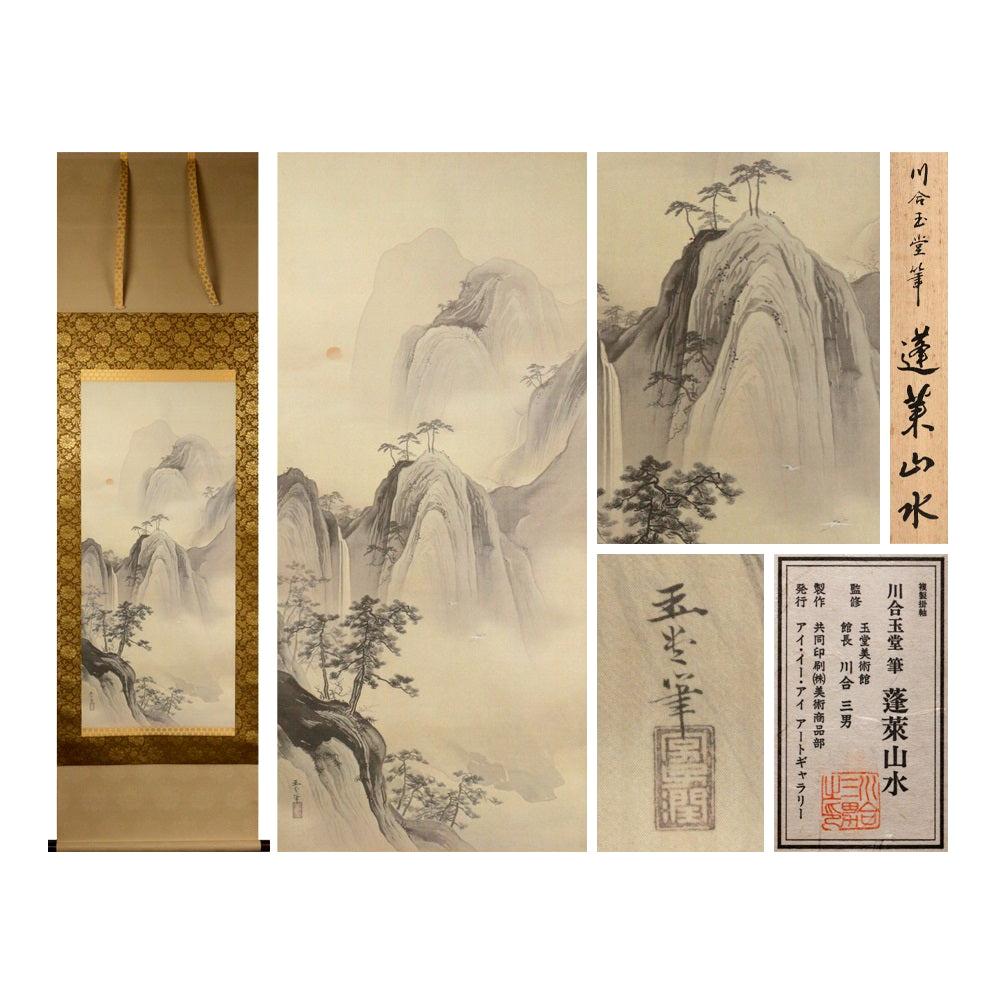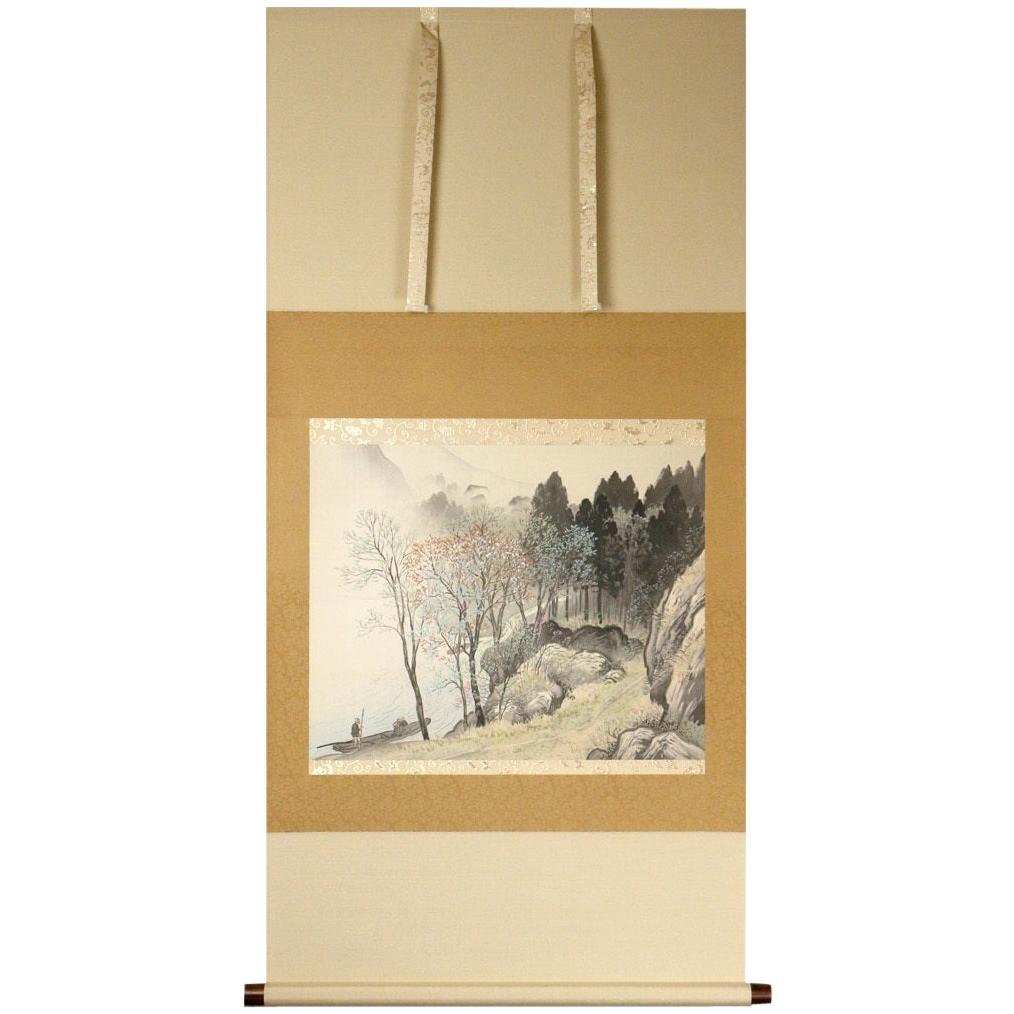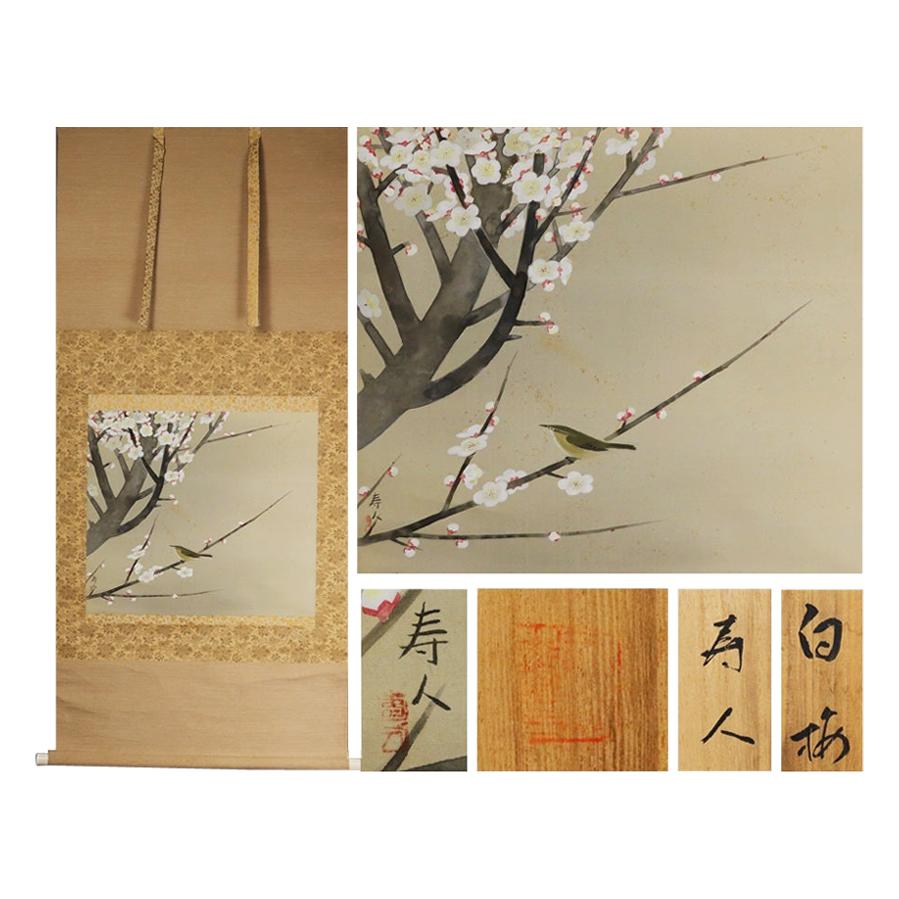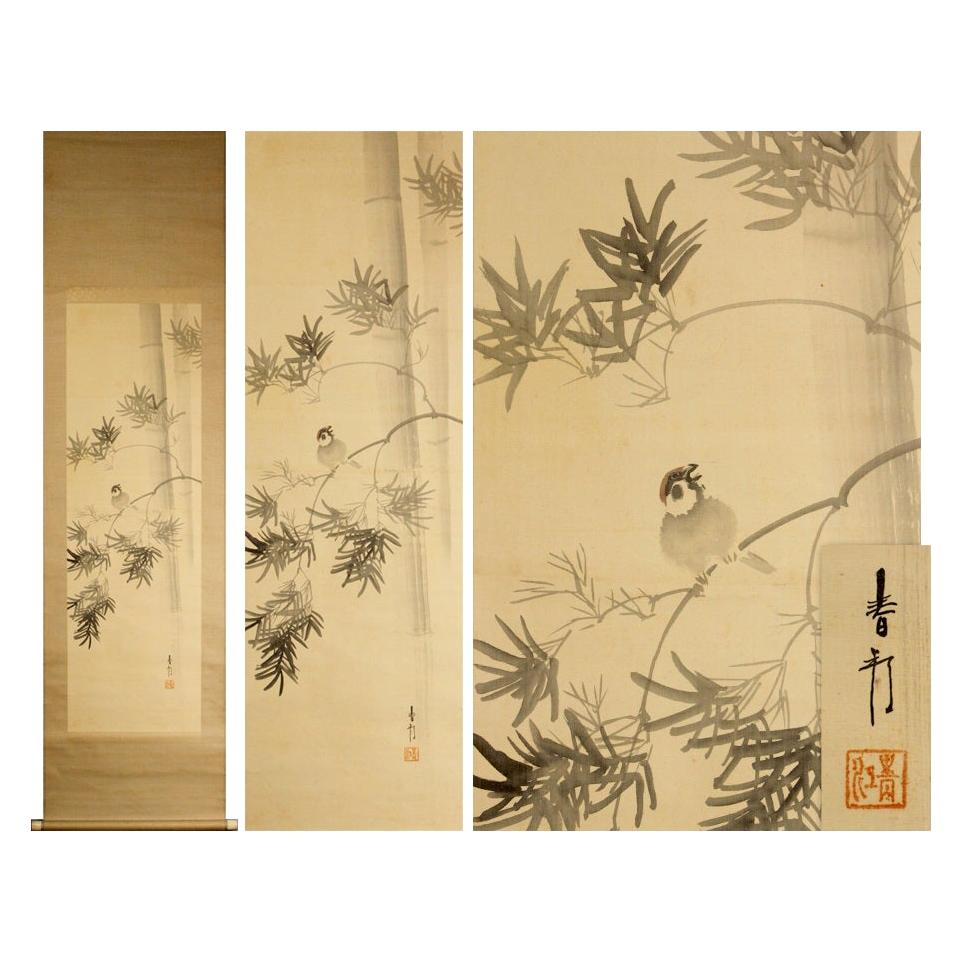Items Similar to Artists Kawai Gyokudō Showa Period Scroll Japan 20c Artist Nihonga
Want more images or videos?
Request additional images or videos from the seller
1 of 5
Artists Kawai Gyokudō Showa Period Scroll Japan 20c Artist Nihonga
About the Item
Kawai Gyokudo (?? ??, November 24, 1873-June 30, 1957) was the pseudonym of a Japanese painter in the Nihongo school, active from Meiji through Showa period Japan. His real name was Kawai Yoshisaburo.
Contents
Biography
Gyokudo was born in what is now Ichinomiya city, Aichi Prefecture, as the eldest son of a paper, ink and brush merchant. He went to Kyoto in 1887 to study under Kono Bairei of the Maruyama-Shijo school of painting. In 1896, he moved to Tokyo and he became the student of Hashimoto Gaho, of the Kano school. He also studied Western-style painting and developed a highly personal style, especially in the field of landscape painting.
Gyokudo is noted for his polychrome and occasionally monochrome works depicting the mountains and rivers of Japan in the four seasons, with humans and animals shown as part of the natural landscape. Among his representative works are Futsuka zuki (“The New Moon”), Yuku haru (“The Departing Spring”), Mine-no-yu (“Evening at the Mountain Top”), and Bosetsu (“Snow in the Evening”).
In 1898, Gyokudo joined with Okakura Tenshin and Yokoyama Taikan to found the Nihon Bijutsuin (Japan Fine Art Academy). In 1907, Gyokudo was selected as a judge for the first annual Bunten Exhibition. He became a teacher at the Tokyo Bijutsu Gakko (the forerunner of the Tokyo National University of Fine Arts and Music) in 1919.
In 1940, he was awarded the Order of Culture by the Government of Japan.
Most of his works are preserved and displayed at the Gyokudo Art Museum, in Ome, Tokyo.
As you can see, "High-class crafts" Kawai Gyokudo's "Kaki autumn leaves".
It is a simple yet warm "Kaki autumn leaves", and it is
a work in which the details of a private house are carefully drawn.
¦ Silk books and crafts.
¦ Condition
There is me etc.
¦ Shaft dimensions / approx. 136.5 cm x approx. 67.0 cm.
¦ Paper dimensions / approx. 39.0 cm x approx. 52.5 cm.
¦ Signs / There are inscriptions and seals as you can see.
¦ Box / Box.
- Dimensions:Height: 53.75 in (136.5 cm)Width: 26.38 in (67 cm)Depth: 0.04 in (1 mm)
- Style:Taisho (Of the Period)
- Materials and Techniques:
- Place of Origin:
- Period:
- Date of Manufacture:20th Century
- Condition:Wear consistent with age and use. ■ Silk book. ■ The condition is beautiful. ■ Shaft dimensions / approx. 181.0 cm x approx. 53.0 cm. ■ Painting dimensions / approx. 90.0 cm x approx. 40.0 cm. ■ Signs / There are inscriptions and seals as you can see. ■ Box / Box.
- Seller Location:Amsterdam, NL
- Reference Number:
About the Seller
5.0
Gold Seller
These expertly vetted sellers are highly rated and consistently exceed customer expectations.
Established in 2015
1stDibs seller since 2019
158 sales on 1stDibs
Typical response time: 9 hours
- ShippingRetrieving quote...Ships From: Amsterdam, Netherlands
- Return PolicyA return for this item may be initiated within 14 days of delivery.
More From This SellerView All
- Artists Kawai Gyokudō Showa Period Scroll Japan 20c Artist NihongaLocated in Amsterdam, Noord HollandKawai Gyokudo (?? ??, November 24, 1873-June 30, 1957) was the pseudonym of a Japanese painter in the Nihongo school, active from Meiji through Showa period Japan. His real name was Kawai Yoshisaburo. Contents Biography Gyokudo was born in what is now Ichinomiya city, Aichi Prefecture, as the eldest son of a paper, ink and brush merchant. He went to Kyoto in 1887 to study under Kono Bairei of the Maruyama-Shijo school of painting. In 1896, he moved to Tokyo and he became the student of Hashimoto Gaho, of the Kano school. He also studied Western-style painting and developed a highly personal style, especially in the field of landscape painting. Gyokudo is noted for his polychrome and occasionally monochrome works depicting the mountains and rivers of Japan in the four seasons, with humans and animals shown as part of the natural landscape. Among his representative works are Futsuka zuki (“The New Moon”), Yuku haru (“The Departing Spring”), Mine-no-yu (“Evening at the Mountain Top”), and Bosetsu (“Snow in the Evening”). In 1898, Gyokudo joined with Okakura Tenshin and Yokoyama Taikan...Category
20th Century Japanese Taisho Paintings and Screens
MaterialsSilk
- Artists Suiho Yano Showa Period Scroll Japan 20c Artist NihongaLocated in Amsterdam, Noord HollandAs you can see, it is a work of "Basho / Sparrow" drawn by Midori Yano. Under Basho, this work skillfully depicts the appearance of sparrows forming a flock and singing food. «Su...Category
20th Century Japanese Taisho Paintings and Screens
MaterialsSilk
- Artists Norikuni Kawamura, Showa Period Scroll Japan 20c Artist NihongaLocated in Amsterdam, Noord HollandAs you can see, it is a double box and a box with "Shokakuzu" written by Norikuni Kawamura. The "Shokaku-zu", which is composed of graceful textures, spreads its wings and flies, i...Category
20th Century Japanese Showa Paintings and Screens
MaterialsSilk
- Kawai Gyokudō Nihonga Scene Early 20th Century Scroll Painting Japan ArtistLocated in Amsterdam, Noord HollandIt is a high-quality craft of the work drawn by Kawai Gyokudo as you can see. It creates a texture that makes you feel a refreshing breeze, and it is a tasty work that is carefully drawn even to lush bushes and trees. (A guidebook (bookmark) is also included.) "Kawaai Gyokudo" [1873-1957] Japanese painter. Born in Aichi. His real name is Hosaburo. Another issue, Ikuan. At the beginning, he studied under the Shijo school and then Masakuni Hashimoto to study the Kano school, and established his own style as a moderate landscape painting full of poetry. Received the Order of Culture. Work "Ayaame" etc. ¦ Paper books and crafts. ¦ The condition is beautiful. ¦ Axial dimension/approx. 128.0 cm x 62.0 cm. ¦ Paper size/approx. 40.5 cm x 51.0 cm. ¦ Incorporation/There are inscriptions/incorporations as you see. ¦ Box/Box. awai Gyokudo (?? ??, November 24, 1873 – June 30, 1957) was the pseudonym of a Japanese painter in the nihonga school, active from Meiji through Showa period Japan. His real name was Kawai Yoshisaburo. Contents Biography Gyokudo was born in what is now Ichinomiya city, Aichi Prefecture, as the eldest son of a paper, ink and brush merchant. He went to Kyoto in 1887 to study under Kono Bairei of the Maruyama-Shijo school of painting. In 1896, he moved to Tokyo and he became the student of Hashimoto Gaho, of the Kano school. He also studied Western-style painting and developed a highly personal style, especially in the field of landscape painting. Gyokudo is noted for his polychrome and occasionally monochrome works depicting the mountains and rivers of Japan in the four seasons, with humans and animals shown as part of the natural landscape. Among his representative works are Futsuka zuki (“The New Moon”), Yuku haru (“The Departing Spring”), Mine-no-yu (“Evening at the Mountain Top”), and Bosetsu (“Snow in the Evening”). In 1898, Gyokudo joined with Okakura Tenshin and Yokoyama Taikan...Category
Early 20th Century Japanese Taisho Paintings and Screens
MaterialsSilk
- Artists Miyao Jujin, Showa Period Bird and Plum Scroll Japan 20c Artist NihongaLocated in Amsterdam, Noord HollandAs you can see, Hisato Miyao, Okayama Prefecture, wrote "Shiraume" plum and warbler, and comes with a box. It is a plum and warbler figure expressed in a truly wonderful color, and...Category
20th Century Japanese Showa Paintings and Screens
MaterialsSilk
- Artists Miyao Jujin, Showa Period Bird and Plum Scroll Japan 20c Artist NihongaLocated in Amsterdam, Noord HollandAs you can see, this work depicts a sparrow in a bamboo grove with sunlight shining through it. ¦ Silk book / handwriting. ¦ There are some discolorations in the state era. ...Category
20th Century Japanese Showa Paintings and Screens
MaterialsSilk
You May Also Like
- Japanese Showa Period Peacocks Painted on SilkLocated in Rio Vista, CAColorful Japanese ink and color on silk Showa painting of a pair of peacocks. Vivid colors and beautiful details with a signature and seal on right side bottom. Framed in a midcentur...Category
20th Century Japanese Showa Paintings and Screens
MaterialsSilk, Plexiglass, Paper, Wood
- Large Antique Japanese Scroll Depicting a Nesting Crane, Taisho PeriodLocated in Prahran, VictoriaLarge and exceptional Japanese hanging scroll with a realistically painted depiction of a nesting crane by Yoshifuji Yoshio, Taisho/Showa perio...Category
Early 20th Century Japanese Taisho Paintings and Screens
MaterialsPaper, Silk
- Japan Scroll Painting, Meiji PeriodLocated in Pasadena, CAThis is a wonderful example of a Meiji Period screen painting of Japanese Tanuki or racoon dogs in a landscape. The Tanuki is considered to be a mythical creature Japanese culture. T...Category
Antique Late 19th Century Japanese Meiji Paintings and Screens
MaterialsFabric, Paint
- Japanese Showa Period Folding Screen with Painted CranesLocated in New York, NYJapanese Showa period four panel folding screen finely painted with a theme of cranes in four elegant positions. The piece is signed and was made in circa 1950 in Japan. In great vi...Category
Vintage 1950s Japanese Showa Paintings and Screens
MaterialsFabric, Wood, Paint
- Japanese Late Meiji-Early Showa Period Six-Panel ScreenLocated in New York, NYThis six panel Japanese screen, produced early 20th century, amidst the late Meiji to early Showa period, comes set within a black lacquer frame, with paintings of various foliage, f...Category
Early 20th Century Japanese Paintings and Screens
MaterialsPaper, Wood
- Japanese Six-Panel Screen, Late Meiji-Early Showa PeriodLocated in New York, NYAn elegant six panel screen, produced in Japan within the early 20th century period, circa late Meiji to the early Showa period, which comes set within a black lacquer frame, depicti...Category
Early 20th Century Japanese Paintings and Screens
MaterialsPaper, Wood
Recently Viewed
View AllMore Ways To Browse
Display Scroll
Arts Crafts Japanese
Vintage Japanese House
Japanese Arts And Crafts
Showa Period
Japanese Screens Four
Ink Scroll
Japanese Scroll Art
Japanese Autumn
Japanese Brushes
Japanese Brush
Asian Mountain Painting
Japanese Silk Painting 20th Century
Asian Scroll Painting
Springer Scroll
Vintage Japanese Silk Screen
Japanese Silk Painting Ink
Japanese Scrolls Painting





